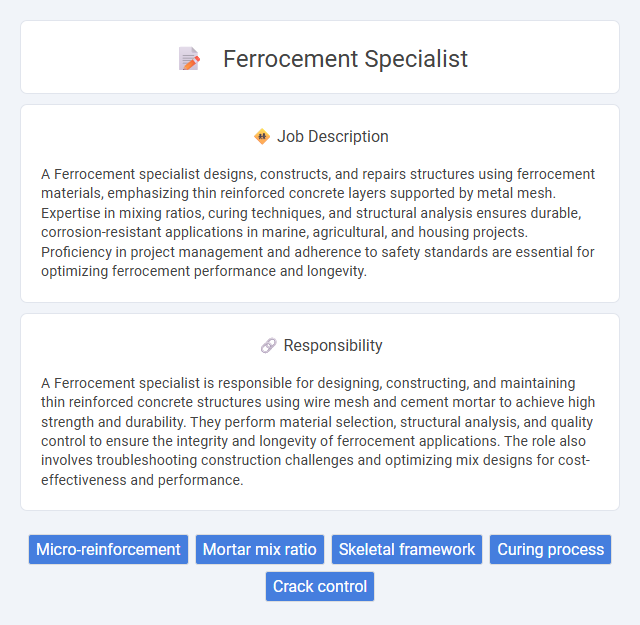
A Ferrocement specialist designs, constructs, and repairs structures using ferrocement materials, emphasizing thin reinforced concrete layers supported by metal mesh. Expertise in mixing ratios, curing techniques, and structural analysis ensures durable, corrosion-resistant applications in marine, agricultural, and housing projects. Proficiency in project management and adherence to safety standards are essential for optimizing ferrocement performance and longevity.
Individuals with strong attention to detail and physical stamina are likely suited for a Ferrocement specialist role, as the job often involves hands-on construction and intricate mixing processes. Those who thrive in environments requiring precision and problem-solving may find this career fulfilling, while people with limited manual dexterity or aversion to labor-intensive tasks might face challenges. The probability of job satisfaction increases if candidates are comfortable working both indoors and outdoors under varying conditions.
Qualification
A Ferrocement specialist requires a strong background in civil engineering or construction technology, with advanced knowledge in ferrocement materials and structural design principles. Certifications in construction management, materials science, or specialized ferrocement training courses enhance expertise in mix proportions, application techniques, and quality control. Practical experience in project management and sustainable building methods is essential for optimizing ferrocement structures in various infrastructural applications.
Responsibility
A Ferrocement specialist is responsible for designing, constructing, and maintaining thin reinforced concrete structures using wire mesh and cement mortar to achieve high strength and durability. They perform material selection, structural analysis, and quality control to ensure the integrity and longevity of ferrocement applications. The role also involves troubleshooting construction challenges and optimizing mix designs for cost-effectiveness and performance.
Benefit
A Ferrocement specialist likely brings significant value by enhancing the durability and cost-efficiency of construction projects through their expertise in thin reinforced concrete techniques. They probably reduce material waste and improve structural strength, which can lead to longer-lasting, sustainable buildings. Employers may benefit from their ability to innovate and optimize project timelines while maintaining quality standards.
Challenge
Ferrocement specialists likely encounter challenges in balancing material durability with cost-effectiveness while ensuring structural integrity. There is a probability that they face difficulties in adapting traditional construction techniques to modern design demands and environmental conditions. Managing precise mixture ratios and reinforcing mesh placement may present ongoing obstacles in achieving optimal performance.
Career Advancement
A Ferrocement specialist leverages expertise in thin reinforced concrete construction to design durable, cost-effective structures such as water tanks, boats, and architectural elements. Mastery in this niche field enables career advancement into roles like project manager, structural consultant, or research and development engineer within construction and infrastructure companies. Proficiency in material science, innovative construction techniques, and sustainable practices further enhances job prospects and leadership opportunities.
Key Terms
Micro-reinforcement
A Ferrocement specialist focuses on the innovative use of micro-reinforcement techniques to enhance the structural strength and durability of thin cementitious elements. Expertise in applying wire mesh and fine steel rods within cement matrices ensures superior crack resistance and load distribution in applications such as water tanks, boat hulls, and architectural panels. Mastery in material composition, micro-reinforcement placement, and curing processes is critical for optimizing performance and extending the lifespan of ferrocement structures.
Mortar mix ratio
Ferrocement specialists expertly design and apply mortar mix ratios essential for constructing durable and crack-resistant structures. The optimal mortar mix typically consists of a cement-to-sand ratio of 1:2 to 1:3, ensuring proper bonding and strength with wire mesh reinforcement. Precise water-to-cement ratio management is crucial to achieve workability without compromising structural integrity in ferrocement applications.
Skeletal framework
A Ferrocement specialist designs and constructs skeletal frameworks using wire mesh and cement mortar to create durable, lightweight structures. Proficiency in selecting appropriate mesh types, optimizing wire gauge, and applying uniform cement coatings ensures structural integrity and resistance to cracking. Expertise in skeletal framework techniques is critical for applications such as water tanks, boat hulls, and thin shell constructions where strength-to-weight ratio is paramount.
Curing process
A Ferrocement specialist ensures the optimal curing process to enhance the material's strength and durability by maintaining consistent moisture levels for at least 7 to 14 days. Proper curing involves frequent water spraying or covering structures with wet burlap, preventing premature drying and cracking. Mastery of curing techniques directly impacts the longevity and structural integrity of ferrocement applications in construction and marine projects.
Crack control
A Ferrocement specialist focuses on advanced crack control methods to enhance the durability and structural integrity of ferrocement structures. Utilizing techniques such as fiber reinforcement and optimized mix design, they minimize micro-cracking and improve tensile strength. Their expertise ensures long-lasting, crack-resistant construction suitable for diverse applications like water tanks, boats, and architectural elements.
 kuljobs.com
kuljobs.com